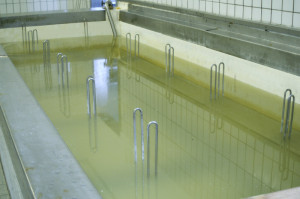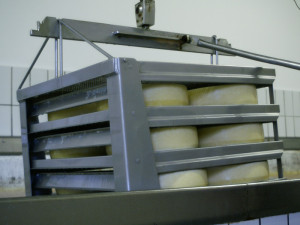The important rind from the cheese
Cheese rind = surface protection for cheese
To protect the cheese wheel, it is put into salt bath or turned into dryThe dry matter refers to that portion of the cheese that remains after removal of the water contained. The more water is removed from the cheese, the lower its dry matter and vice versa. » More info salt. The salt removes water from the cheese and it dries faster. So the rind is formed.
In addition, the salt protects against unwanted mold.
Certain cheeses get an extra treatment after salting. In order to obtain the white surface mold of the soft cheese Camembert, this is e.g. treated with a mushroom cure. For the so-called redAerobic cheese ripening means cheese ripening with oxygen. » More info smearRed smear is a surface threatment method used during cheese making and maturing. » More info at e.g. dairymen cheese provide special bacterial culturesMold cultures are aroma-forming noble molds that grow on the surface (white noble mold) or inside a cheese (blue and green mold). » More info (red cultureBacterium Linens (red culture bacteria) are brushed with salt water on the cheese. » More info), with which the cheese rind is lubricated.
After this step, the cheese is ready for maturing. Here the cheese camps for days, weeks, months to years. By evaporating further water, the rind solidifies.
The cheese care in the maturing cellar

The cheese careAffine cheese - Care of the cheese to the optimal ripening point. Under the experienced hands of Cheese Affineure, cheese reaches its perfect culinary delight. » More info is associated with great effort. The cheese is regularly turned over by the cheese maker, brushed and washed. Mountain cheese and other varieties are additionally rubbed with brine for a particularly hard bark.
Once the cheese has completed the maturing process, it is ready for enjoyment.
Is the cheese rind always enjoyable?
The rind of dayries are edible without problems. The naturally formed cheese rind can, if not further treated, be eaten without hesitation.
Care should be taken only in pregnant women, the elderly and people with a weakened immune system, as on the surface special bacteria, the Listeria, can settle.
Not every cheese rind is a natural one!
Some cheese is packed after the salt bath by the manufacturer in a plastic foil. In this closed state, no bark can form. This “plastic rind” should not be consumed.
Also the plastic casing attached to the naturalHere in Austria, we call our fresh, natural milk for our cheese production hay milk (hay mild standard) - in Germany it is different. » More info rind, which is intended to further protect the cheese in the case of solid and semi-solid varieties, must also be removed before the cheese is eaten. The manufacturer must point this out to “plastic coating not suitable for consumption”.
An exception is the vacuum packaging just for short transport.

Surface treatment with natamycin
Another way to protect the cheese against mildew is the surface treatment with natamycinAs a preservative for the treatment of cheese rind, natamycin prevents yeast and mold infestation - and relieves the cheese from complex cheese care. » More info. This is allowed for hard cheeseThe Vorarlberger Bergkäse (mountain cheese) is a regional cheese specialty from the Austrian province Vorarlberg. » More info, semi-hard cheese and semi-hard cheese.
Unfortunately, mushrooms are not prohibited on cheese: natamycin acts as an antibiotic (a penicillin-like additive (E 235) with antibiotic effect) and is used in medicine in the treatment of various fungal infections in humans. Despite the consumption warning of BfR and MRI, the use of natamycin in cheese is allowed.
Taking natamycin frequently can lead to resistance to the substance. That’s why the rind must be cut away with cheese that has been treated with it – and that generously. The additive is detectable up to five millimeters below the surface.


















